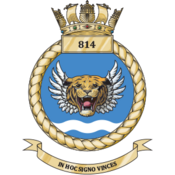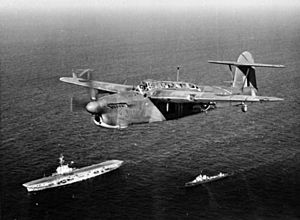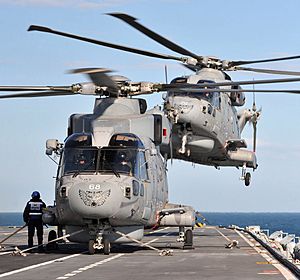814 Naval Air Squadron facts for kids
Quick facts for kids 814 Naval Air Squadron |
|
|---|---|

Squadron badge
|
|
| Active |
|
| Country | |
| Branch | |
| Type | Helicopter flying squadron |
| Role | Anti submarine warfare |
| Part of | Fleet Air Arm |
| Home station | RNAS Culdrose |
| Nickname(s) | 'The Flying Tigers' |
| Motto(s) | In hoc signo vinces (Latin for 'In this sign you will conquer') |
| Aircraft | AgustaWestland Merlin HM2 |
| Battle honours | Atlantic (1940) |
| Website | 814 Naval Air Squadron |
| Commanders | |
| Current commander |
Commander Amy Gaunt |
814 Naval Air Squadron, also known as 814 NAS, is a special group of pilots and crew in the Royal Navy. They are nicknamed the Flying Tigers. This squadron flies Merlin HM2 helicopters. These helicopters are used to find and stop enemy submarines. The squadron is based at Royal Naval Air Station (RNAS) Culdrose in Cornwall, England. 814 NAS first started in December 1938. It has been closed down and restarted several times since then.
Contents
What the Flying Tigers Do
814 Naval Air Squadron uses its Merlin HM2 helicopters for many important jobs. Their main role is anti-submarine warfare (ASW). This means they hunt for submarines underwater.
Merlin Helicopter Capabilities
The Merlin HM2 helicopters are based at RNAS Culdrose in Cornwall. Besides finding submarines, they can also:
- Help stop pirates on the sea.
- Deliver aid to people who need help.
- Carry injured people to safety (called casualty evacuation).
- Lift heavy loads (up to 3.8 tonnes) using a sling.
- Perform search and rescue missions.
- Watch over the sea for security.
The Merlin helicopters can carry different weapons. These include BAE Systems Sting Ray torpedoes and Mark 11 depth charges. They can also have a powerful Browning M3m .50 calibre machine gun.
The squadron has more than 200 people working for it. This makes it the largest Merlin squadron in the Fleet Air Arm.
History of the Squadron
The 814 Naval Air Squadron has a long and interesting history. They have flown many different types of aircraft.
Second World War Missions
814 Naval Air Squadron was first formed in December 1938. At that time, they flew six Fairey Swordfish Mk I planes. These planes were used to find enemy ships and launch torpedoes.
West Africa Patrols
In January 1939, the squadron joined the aircraft carrier HMS Ark Royal. When the Second World War started, they moved to HMS Hermes. HMS Hermes sailed to West Africa. There, the squadron helped look for the German warship Admiral Graf Spee.
They also took part in the Battle of Dakar in July 1940. During this battle, they attacked the French battleship Richelieu. Even though there was heavy enemy fire, they hit the battleship once. This hit put the battleship out of action for over a year. For their actions in the Battle of the Atlantic in 1940, the squadron received a special award.
Indian Ocean Support
In December 1940, HMS Hermes and the squadron went to the Indian Ocean. The squadron helped ground forces in British Somaliland in East Africa. They helped capture five enemy merchant ships. In May 1941, they supported the Royal Air Force (RAF) in Iraq. Later, they protected convoys (groups of ships) in the Indian Ocean.
In April 1942, while the squadron was on land, HMS Hermes was sunk by Japanese planes. This happened near Ceylon (now Sri Lanka). 814 NAS was then closed down in December 1942 in Ceylon.
Far East Operations
The squadron was restarted in July 1944 at RNAS Stretton in Cheshire. They now flew the Fairey Barracuda Mk II. This plane could drop torpedoes and bombs. In March 1945, they joined HMS Venerable and went to the Far East. They flew patrols but did not see any more fighting during the war.
Cold War Era
After the war, the squadron continued its role in finding submarines. They flew different aircraft like the Fairey Firefly, Grumman Avenger, and Fairey Gannet. They served on ships like HMS Vengeance. In 1951, they won the Boyd Trophy for being very good at their job.
In 1960, the squadron got its first helicopter, the Westland Whirlwind HAS.7. Later, they used the Westland Wessex HAS.1. In 1967, the Wessex HAS.3 was introduced. This was their first helicopter with radar. During this time, the squadron was on HMS Victorious and HMS Hermes. They patrolled east of the Suez. In 1968, 814 NAS won the Boyd Trophy again. This was for their excellent work at sea with the Wessex HAS.3. The squadron was closed down for a second time in July 1970.
The Sea King Helicopters
The squadron was restarted in March 1973 at RNAS Prestwick. They now had four Westland Sea King HAS.1 helicopters. These helicopters were specially made for finding submarines. They went on tours with HMS Bulwark and HMS Hermes. They helped British citizens leave during the 1974 Turkish invasion of Cyprus. That same year, they won the Australia Shield for being ready for action.
In 1977, the Sea King HAS.2 was introduced. This made 814 NAS the first Royal Navy squadron to use a helicopter with special passive sonar equipment. On April 9, 1976, 814 NAS moved from Prestwick to Royal Naval Air Station (RNAS) Culdrose in Cornwall. They have been there ever since. By the end of 1976, they had nine helicopters.
In 1979, the squadron became a full member of the NATO Tiger Association. This group helps air forces from NATO countries work together.
By the time of the Falklands War in April 1982, the squadron was using the improved Sea King HAS.5. In August 1982, they joined HMS Illustrious for patrols in the South Atlantic. Their abilities improved even more in October 1990 when they got the Sea King HAS.6. This version of the Sea King was used by the squadron during the Gulf War in 1991. They operated from the carrier HMS Invincible. Later, they saw action in the Bosnian War and Kosovo Wars. In December 2000, the squadron was closed down for the third time.
The 21st Century
The squadron was restarted in October 2001 at RNAS Culdrose. They now flew the Merlin HM1 helicopter. The Merlin replaced the Sea King helicopters for finding submarines. It can be used from ships or from land for many different sea missions.
The squadron's Merlins have been used in real operations. They served on HMS Illustrious during the Iraq War (Operation Telic) and in the Persian Gulf area. In May 2012, they took part in Exercise Joint Warrior off the coast of Scotland. They were again with HMS Illustrious.
During the London 2012 Olympics, the squadron went to RNAS Yeovilton in Somerset. They helped with security operations at sea. From Yeovilton, the Merlins could quickly reach amphibious transport dock HMS Bulwark. This ship was the police command center for the Olympic Sailing Regatta in Weymouth Bay.
In December 2014, the Merlin HM1 helicopters were replaced with the newer Merlin HM2. These upgraded aircraft have a new mission system and a digital cockpit. They also have a special camera and a new sonar system.
In early 2016, two aircraft and over sixty people from 814 NAS took part in Exercise Dynamic Manta 16. This was a big anti-submarine warfare exercise in the Mediterranean. They were based at Naval Air Station Sigonella in Sicilly. They worked with eight other NATO countries. The squadron returned for the same exercise in 2017 and 2018.
In March 2018, the aircraft and people from 829 Naval Air Squadron joined 814 NAS. This created the largest Merlin Fleet Air Arm squadron ever. Both squadrons were based at RNAS Culdrose.
Aircraft Flown by the Squadron
The 814 Naval Air Squadron has used many different types of aircraft throughout its history.
- Fairey Swordfish Mk I (1938–1942)
- Fairey Barracuda Mk II
- Fairey Firefly FR.1, FR.4, Mk 5 and AS.6
- Grumman Avenger AS.4 and AS.5
- Fairey Gannet AS.4 and T.2
- Westland Whirlwind HAS.7
- Westland Wessex HAS.1 and HAS.3
- Westland Sea King HAS.1, HAS.2/2a, HAS.5 and HAS.6 (1973–2000)
- AgustaWestland Merlin HM1 and HM2 (2000 – present)
Images for kids
-
An 814 NAS Sea King HAS.6 helicopter at RAF Mildenhall in 1986.
Squadron Traditions

The squadron has some special traditions and connections.
Nickname and Badge
The squadron's nickname is 'the Flying Tigers'. Their badge shows a tiger's head. This represents their membership in the NATO Tiger Association.
Squadron Connections
The 814 Naval Air Squadron is connected to these groups:
- Devon and Cornwall Constabulary (Police force)
- The Gold and Silver Wyre Drawers (An old London company)
- Leicester Tigers (A rugby team)
- NATO Tiger Association (An international military group)
- Solent University Royal Naval Unit (A university naval training group)
- Treliske Hospital (A hospital in Cornwall)
- Erewash Borough Council (A local government in Derbyshire)








